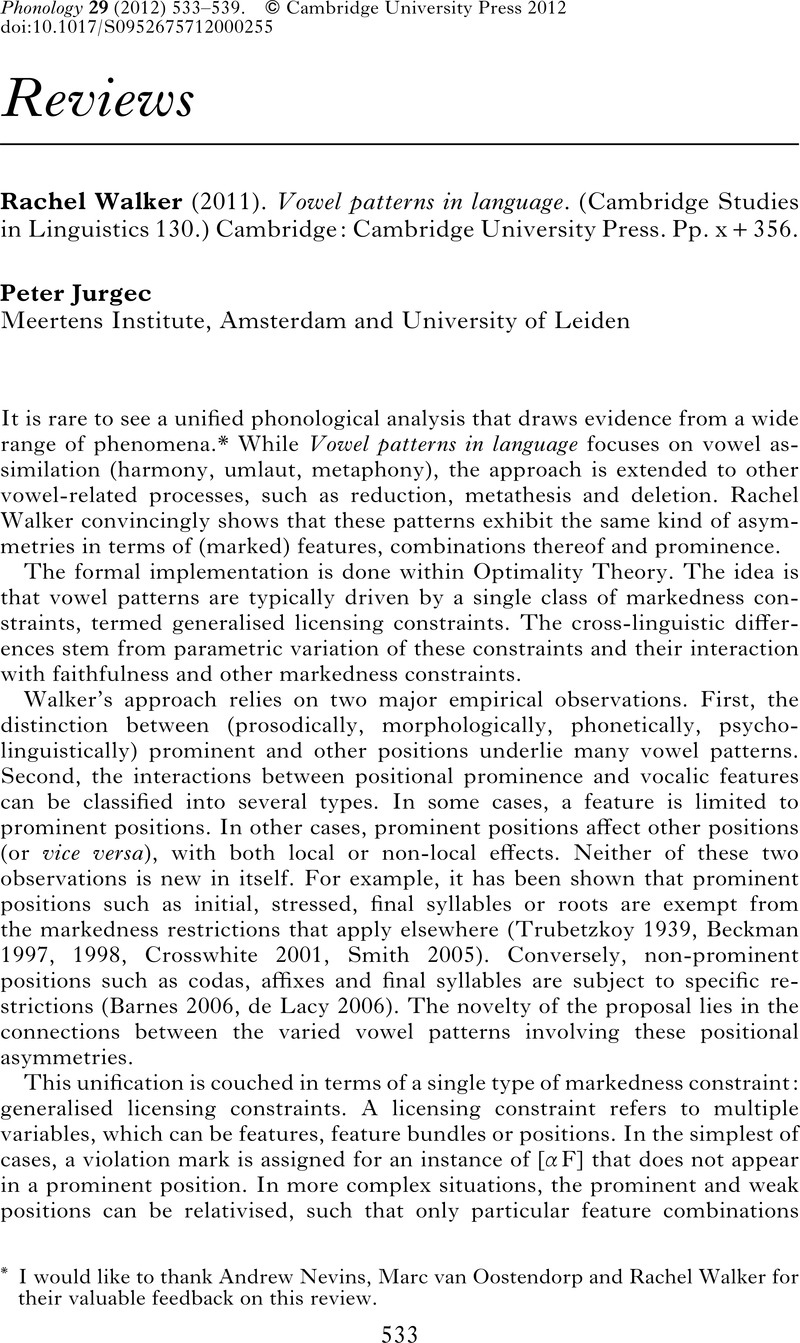No CrossRef data available.
Article contents
Rachel Walker (2011). Vowel patterns in language. (Cambridge Studies in Linguistics 130.) Cambridge: Cambridge University Press. Pp. x + 356.
Published online by Cambridge University Press: 13 December 2012
Abstract
An abstract is not available for this content so a preview has been provided. Please use the Get access link above for information on how to access this content.

- Type
- Book Review
- Information
- Copyright
- Copyright © Cambridge University Press 2012
References
REFERENCES
Baković, Eric (2000). Harmony, dominance, and control. PhD dissertation, Rutgers University. Available as ROA-360 from the Rutgers Optimality Archive.Google Scholar
Barnes, Jonathan (2006). Strength and weakness at the interface: positional neutralization in phonetics and phonology. Berlin & New York: Mouton de Gruyter.CrossRefGoogle Scholar
Beckman, Jill N. (1997). Positional faithfulness, positional neutralisation and Shona vowel harmony. Phonology 14. 1–46.CrossRefGoogle Scholar
Beckman, Jill N. (1998). Positional faithfulness. PhD dissertation, University of Massachusetts, Amherst. Available as ROA-234 from the Rutgers Optimality Archive.Google Scholar
Calabrese, Andrea (1988). Towards a theory of phonological alphabets. PhD thesis, MIT.Google Scholar
Cole, Jennifer & Kisseberth, Charles (1994). An optimal domains theory of harmony. Studies in the Linguistic Sciences 24. 101–114.Google Scholar
Crosswhite, Katherine M. (2001). Vowel reduction in Optimality Theory. New York & London: Routledge.Google Scholar
de Lacy, Paul (2006). Markedness: reduction and preservation in phonology. Cambridge: Cambridge University Press.CrossRefGoogle Scholar
Flack, Kathryn (2007). Templatic morphology and indexed markedness constraints. LI 38. 749–758.Google Scholar
Gouskova, Maria (2007). The reduplicative template in Tonkawa. Phonology 24. 367–396.CrossRefGoogle Scholar
Hansson, Gunnar Ólafur (2001). Theoretical and typological issues in consonant harmony. PhD dissertation, University of California, Berkeley.Google Scholar
Hansson, Gunnar Ólafur (2007). Blocking effects in agreement by correspondence. LI 38. 395–409.Google Scholar
Itô, Junko & Mester, Armin (1995). Japanese phonology. In Goldsmith, John A. (ed.) The handbook of phonological theory. Cambridge, Mass. & Oxford: Blackwell. 817–838.Google Scholar
Ito, Junko & Mester, Armin (2003). Japanese morphophonemics: markedness and word structure. Cambridge, Mass.: MIT Press.CrossRefGoogle Scholar
Jurgec, Peter (2011). Feature spreading 2.0: a unified theory of assimilation. PhD dissertation, University of Tromsø. Available (October 2012) athttp://ling.auf.net/lingbuzz/001281.Google Scholar
Kisseberth, Charles (1994). On domains. In Cole, Jennifer & Kisseberth, Charles (eds.) Perspectives in phonology. Stanford: CSLI. 133–166.Google Scholar
Li, Bing (1996). Tungusic vowel harmony: description and analysis. The Hague: Holland Academic Graphics.Google Scholar
McCarthy, John J. (2003). OT constraints are categorical. Phonology 20. 75–138.CrossRefGoogle Scholar
McCarthy, John J. (2004). Headed spans and autosegmental spreading. University of Massachusetts, Amherst. Available as ROA-685 from the Rutgers Optimality Archive.Google Scholar
Nevins, Andrew (2010). Locality in vowel harmony. Cambridge, Mass.: MIT Press.CrossRefGoogle Scholar
Paster, Mary (2004). Vowel height harmony and blocking in Buchan Scots. Phonology 21. 359–407.CrossRefGoogle Scholar
Pater, Joe (2000). Non-uniformity in English secondary stress: the role of ranked and lexically specific constraints. Phonology 17. 237–274.CrossRefGoogle Scholar
Pater, Joe (2007). The locus of exceptionality: morpheme-specific phonology as constraint indexation. In Bateman, Leah, O'Keefe, Michael, Reilly, Ehren & Werle, Adam (eds.) Papers in Optimality Theory III. Amherst: GLSA. 259–296.Google Scholar
Pater, Joe (2009). Morpheme-specific phonology: constraint indexation and inconsistency resolution. In Parker, Steve (ed.) Phonological argumentation: essays on evidence and motivation. London: Equinox. 123–154.Google Scholar
Potts, Christopher, Pater, Joe, Jesney, Karen, Bhatt, Rajesh & Becker, Michael (2010). Harmonic Grammar with linear programming: from linear systems to linguistic typology. Phonology 27. 77–117.CrossRefGoogle Scholar
Rhodes, Russell (2011). Vowel harmony as Agreement by Correspondence. Ms, University of California, Berkeley. Available (October 2012) athttp://linguistics.berkeley.edu/∼russellrhodes/pdfs/abc_vh.Google Scholar
Rose, Sharon & Walker, Rachel (2004). A typology of consonant agreement as correspondence. Lg 80. 475–531.Google Scholar
Smith, Jennifer L. (2005). Phonological augmentation in prominent positions. London & New York: Routledge.Google Scholar
Smolensky, Paul (2006). Optimality in phonology II: harmonic completeness, local constraint conjunction, and feature domain markedness. In Smolensky, Paul & Legendre, Géraldine (eds.) The harmonic mind: from neural computation to optimality-theoretic grammar. Vol. 2: Linguistic and philosophical implications. Cambridge, Mass.: MIT Press. 27–160.Google Scholar
Trubetzkoy, Nikolai S. (1939). Grundzüge der Phonologie. Göttingen: Vandenhoeck & Ruprecht.Google Scholar
Vaysman, Olga (2009). Segmental alternations and metrical theory. PhD dissertation, MIT. Available as ROA-1011 from the Rutgers Optimality Archive.Google Scholar
Walker, Rachel (2000). Yaka nasal harmony: spreading or segmental correspondence? BLS 26. 321–332.CrossRefGoogle Scholar


